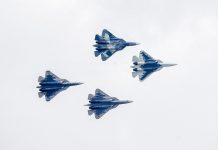Increasing drone attacks inside Russian territory have prompted Russian engineers to reportedly develop an all-encompassing anti-drone system that is capable of independent operation.
Vladislav Kustarev, Development Director of Stupor LLC, told RIA Novosti on February 26 that his organization developed ‘Stupor’ to protect assets from drones. The system is also capable of detecting and suppressing drones in several ways.
“We have developed a single “Stupor” system based on complementary detection complexes, such as a radar station, a radio frequency scanner, an optical drone recognition station, and means of countermeasures — barrier interference equipment and a coordinate subsubstitution complex,” he explained.
To achieve increased reliability and lower the number of false positives, the “Stupor” developers combined devices operating on different principles into the system using their software. “The software complex has artificial intelligence, which allows Stupor to work without the help of the operator of the complex,” Kustarev said.
“Reporting and archived information about events can be uploaded directly to the phone. In addition, it is possible to integrate the means of detection and counteraction of other manufacturers into our system,” he also mentioned.
He pointed out that the deployment of these systems is crucial as, under special operations circumstances, Ukrainian UAVs frequently target military installations and infrastructure in central Russia. However, it’s not always a good idea to attack them with air defenses or to waste money on inexpensive drones — which are sometimes “reflashed” civilian drones — and expensive ammunition.
When discussing the tactical and technological features of “Stupor,” Kustarev mentioned that the system’s “Storm” and “Shtil” complexes could locate and seize targets up to five kilometers away. Additionally, the “Pars” protection method uses a 360-degree schematic to create a “dome” and a narrow beam of directed action to suppress the UAV up to two kilometers away.

This is not the first time that Russian media has reported on the capabilities of anti Stupor anti-drone system. Russian state news agency TASS reported in July 2023 that the Stupor, a cutting-edge electromagnetic weapon against unmanned aerial vehicles, was used in Ukraine for the first time.
Explaining how this novel technology works, the source told TASS, “Just as you press a button, Stupor jams the operator’s signal to the drone. After that, the drone is neutralized and forced to land in a designated area. The need for such portable anti-drone weapons became evident because the Ukrainian troops are using a large number of UAVs and various small copters,” he said.
TASS noted that a prototype of the device was unveiled at the Army-2017 International Military-Technical Forum. With Ukraine accruing long-range drone strike capability, the work on anti-drone systems has become more robust.
The source did not mention the precise location of the anti-drone weapon’s use at the time. The specifications of the device too, are not known for now. However, media reports from last year have noted that the weapon blocks channels that a drone uses by releasing its electromagnetic pulses. The result is that the drone crashes after losing communication with its operator during its erratic flight.
Within the electro-optical frequency band, the device can block a hostile drone’s photo and video cameras, as well as its navigation and transmission channels. The grid and an automobile battery can both be used to charge it. However, EurAsian Times could not independently verify these claims, and it hasn’t been officially established if the drone has been tested in Ukraine, like several new-age weapon systems in Russia.
Interestingly, the developers of Stupor have reiterated its capabilities at a time when Ukraine has upped its deadly drone assaults against Russia.
That's what we call a jackpot.
Our drone pilots found an enemy hangar with weapons, that the occupiers planned to use for the attack, and destroyed it.The enemy losses are:
◾️Two C60 anti-aircraft artillery complexes
◾️Two T-72 tanks
◾️BMP-3 IFV
◾️Terminator Tank Support… pic.twitter.com/53Ty8sR3JP— Defense of Ukraine (@DefenceU) February 21, 2024
It comes right after a video was published showing Ukrainian FPV drone operators aiming their drones at a significant concentration of Russian military equipment after locating a warehouse in the south of Ukraine.
The attack drones broke into the hangar, which was filled with expensive equipment, and began destroying the expensive armaments.
Ukraine’s Swelling Drone Inventory
Outgunned by the superior Russian military, Ukraine took to modifying civilian drones and producing combat drones that could strike Russian assets in a far more convenient fashion and at a lower cost. Ukraine’s drone arsenal has expanded significantly in the two years of war with Russia.
Earlier this month, Ukrainian President Volodymyr Zelensky announced the creation of an independent branch of the Ukrainian Armed Forces for drones. Additionally, Ukraine’s digital minister, Mykhailo Fedorov, said Ukraine will develop thousands of long-range drones that can penetrate far into Russia.
There are currently up to ten businesses producing drones that can travel to St. Petersburg and Moscow. “The category of long-range kamikaze drones is growing, with a range of 300, 500, 700, and 1,000 kilometers. Two years ago, this category did not exist … at all, “Mykhailo Fedorov told Reuters.
Since the beginning of this year, Ukraine has begun a new campaign of airstrikes inside Russia in the first two months of 2024. Important targets have included the big oil refineries in Yaroslavl and Volgograd, as well as the Ust-Luga fuel export terminal outside St. Petersburg on the Baltic Sea.
🇺🇦👍 Ukrainian-made drones account for 90% of all UAVs used by the Defense Forces at the front, – Fedorov
👀 "Ukraine will achieve the goal of producing 1 million drones per year. Tests of the Ukrainian analogue Lancet are being successfully conducted." pic.twitter.com/yhl3BNvTCX
— MAKS 23 🇺🇦👀 (@Maks_NAFO_FELLA) February 25, 2024
Military analysts have noted that the battle has entered a new phase, with Ukraine seeking to turn the fight back to Russia and undermine the Russian military. These attacks have targeted Russia’s energy industry infrastructure, a tactic previously used by Moscow to cripple the Ukrainian warfighting capability.
Against that backdrop, and as Ukraine continues to augment its fleet of attack drones and unleashes them on Russia, developing anti-drone systems becomes imperative. Russia’s ‘Stupor’ may be an answer to the growing drone numbers and FPV attacks on its facilities.
- Contact the author at sakshi.tiwari9555 (at) gmail.com
- Follow EurAsian Times on Google News




